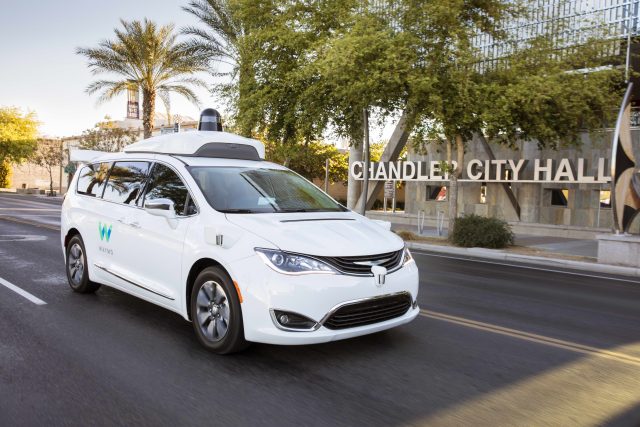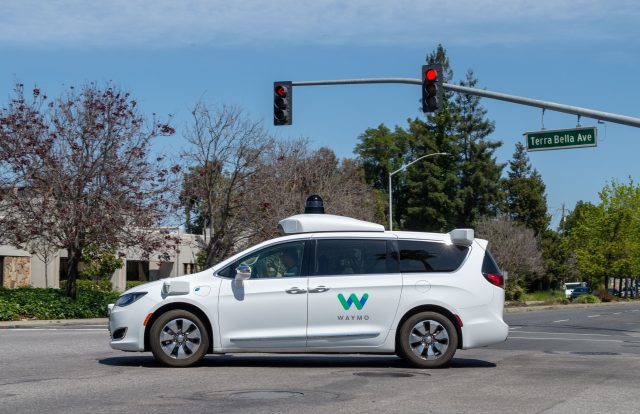No hands across Chandler —
Fully driverless technology is real, and now you can try it in the Phoenix area.
Timothy B. Lee
–

After covering Waymo for several years, I’ve learned to take the company’s announcements with a grain of salt.
In 2018, for example, Waymo said it would launch a fully driverless commercial service by the end of the year. Waymo did release a service called Waymo One in December 2018, but it came with a couple of huge asterisks: every vehicle had a safety driver, and the service was only open to a small group of people.
But today Waymo finally seems to be launching the taxi service it promised two years ago: one that’s fully driverless and open to the public. Waymo told Ars that the service will initially operate in a 50-square-mile area in the Phoenix suburbs of Chandler, Tempe, and Mesa.
Waymo’s rollout of driverless technology has been so slow and confusing that it can be easy to lose sight of what a remarkable accomplishment this is. In the last year or two, as driverless technology has failed to live up to earlier hype, it has become fashionable to claim that driverless technology is still years or even decades away.
But that isn’t true. Members of the public who live in the Chandler area can hail a fully driverless taxi today.
Waymo’s big challenge now is economics, not just technology

Waymo’s decision to offer fully driverless rides to the general public signals that the company believes it can do so safely. The question now is how quickly it can scale its service up nationally and, eventually, globally. That’s a question of economics as much as it is of technology.
The company has been losing tens of millions—perhaps even hundreds of millions—of dollars each quarter. A big part of Waymo’s losses are due to the cost of developing Waymo’s technology. But it’s a safe bet that even paid Waymo One rides have lost Waymo money. Waymo’s safety drivers presumably make at least as much as an Uber or Lyft driver, and the company also has fleet support staff monitoring vehicles remotely. And each Waymo vehicle has expensive sensors and computing hardware not present on a typical Uber or Lyft car.
Eliminating the safety driver is an important step toward making Waymo’s service profitable. But it may not be enough on its own because Waymo says the cars still have remote overseers.
These Waymo staffers never steer the vehicles directly, but they do send high-level instructions to help vehicles get out of tricky situations. For example, a Waymo spokeswoman told me, “if a Waymo vehicle detects that a road ahead may be closed due to construction, it can pull over and request a second set of eyes from our fleet response specialists.” The fleet response specialist can then confirm that the road is closed and instruct the vehicle to take another route.
“Multiple cars at the same time”
The key question for the profitability of Waymo’s rides is likely to be the ratio of vehicles to operators. Waymo probably can’t turn a profit if there’s an operator for every vehicle. But the service becomes more viable if one operator can oversee multiple vehicles—perhaps two or three at the outset, and eventually 10 or 20 vehicles per operator.
A Waymo spokeswoman told Ars that “fleet responders are trained to monitor multiple cars at the same time, but we don’t share specific numbers.” But we can expect this to be a major focus for Waymo in the coming months: reducing the amount of remote monitoring each vehicle requires so that Waymo can reduce its back-office support costs over time.
A key thing to watch here is how quickly Waymo expands its service to additional customers in the existing service area. In Thursday’s blog post, Waymo wrote that “we’ll start with those who are already a part of Waymo One and, over the next several weeks, welcome more people directly into the service through our app.” That could mean that Waymo’s service will be available to everyone in its service territory in several weeks. Or Waymo might expand only slowly—which might be a sign that Waymo’s service is still highly unprofitable.
A Waymo spokeswoman told Ars that, before the pandemic struck in March, “we were serving 1,000 to 2,000 weekly rides total, five to 10 percent of which were fully driverless.” Waymo said it expects to return to that volume of roughly 100 driverless rides per week before the end of the year and then grow from there.
Expansion plans

Enlarge / A Waymo self-driving car doing its thing in May 2019.
The other big question is how long it takes—and how expensive it is—to expand the coverage area. There are three steps for Waymo to expand into a new area. First, the company builds detailed maps of the new territory. Then the company has its cars drive routes in the area with safety drivers to test how its software performs. Finally, once the company is satisfied with the software’s performance, it begins driverless operations.
Waymo took more than three years to complete this process for its initial 50-square-mile service territory around Chandler, Arizona. Obviously, Waymo will need to dramatically speed the process up if it wants to build a national—or even global—taxi service. The next 50 square miles—or even 500 square miles—will probably not take as long as the first 50.
Expanding the Waymo One service footprint to other parts of suburban Phoenix should be straightforward. Waymo may also be able to easily expand to other Southwestern cities with wide roads, few pedestrians, and sunny weather almost all year.
Rain, snow, humans…
Expanding to other parts of the United States may be harder. Major urban centers like San Francisco, New York, and Chicago have a much higher density of vehicles, pedestrians, bicycles, and other obstacles than the Phoenix suburbs. Northern cities like Boston and Minneapolis have heavy snowfall. Almost every metropolitan area gets more rain than Phoenix. It may take more years of work to bring Waymo’s technology to these areas.
Waymo will also have to cope with differences in law and custom. Different states have different laws on things like right-hand turns at red lights. Waymo will have to make sure it complies with the law in each locality. Waymo will also need to tune its vehicles so that its driving style is consistent with that of local drivers.
Still, if Waymo can at least make its service available in the Phoenix area, that could be a big advantage over its rivals. Running a large-scale taxi service in even one metro area will give Waymo a wealth of sensor data and operational experience that will inform the company’s efforts to tackle other regions. Waymo is far from winning the national driverless technology race. But it continues to be the clear industry leader.

